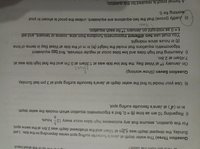You are using an out of date browser. It may not display this or other websites correctly.
You should upgrade or use an alternative browser.
You should upgrade or use an alternative browser.
Does someone know how to do Question 7
- Thread starter Selena378
- Start date
Dr.Peterson
Elite Member
- Joined
- Nov 12, 2017
- Messages
- 16,605
So we don't have to stand on our heads:

Pick which base function you want to use for your first equation, and show us what you've worked out so far (amplitude, period, ...). Then make an attempt at writing an equation, and tell us where you are stuck.
And if you main concern is the proof in part ii, you'll have to show us both of your functions in order to have anything at all to say.

Pick which base function you want to use for your first equation, and show us what you've worked out so far (amplitude, period, ...). Then make an attempt at writing an equation, and tell us where you are stuck.
And if you main concern is the proof in part ii, you'll have to show us both of your functions in order to have anything at all to say.
HallsofIvy
Elite Member
- Joined
- Jan 27, 2012
- Messages
- 7,763
Thank you, Dr. Peterson, for posting the question right side up. My computer terminal doesn't like being turned upside down and it has been years since I stood on my head.
Selena378, "sin(x)" and "cos(x)" both have period \(\displaystyle 2\pi\) and range from -1 to 1. Since the tide, here, has a low of 0.7 meters, at 1:30 A.M., and a high of 2.8 m at 7:45, your function has a period of 2(7:45- 1:30) (one period is "low to high to low) which is 2(7.75- 1.5)= 2(6.25)= 12.5 hours and goes from 0.7 to 2.8 m. The mid-height, since the trig functions will go both above and below by the same amount is (0.7+ 2.8)/2= 3.5/2= 1.75 m. The difference between high and low is 7.5- 2.8= 4.7 m. You want 1.75 plus 4.7 times a sine or cosine.
Since the period is 12.5 hours and the period of sine and cosine is \(\displaystyle 2\pi\) you have to change "12.5" to "\(\displaystyle 2\pi\)". We do that by dividing t by 12.5 and multiplying by \(\displaystyle 2\pi\): \(\displaystyle \frac{2\pi)(t- t_0)}{12.5}\). "\(\displaystyle t_0\)" is whatever time (in hours) you choose as the starting time. That will be the argument of either sine or cosine. If you choose to make the time of high tide, \(\displaystyle t_0\), 7:46 A.M, the starting time you will want to use cosine because cos(0)= 1. If you want to make halfway between high and low tides, \(\displaystyle t_0\), 4:37.5 A.M., the starting time you will want to use sine because sin(0)= 0. If you want to make the time of low tide, \(\displaystyle t_0\), 1:30 A.M. you will want to use -cosine.
Selena378, "sin(x)" and "cos(x)" both have period \(\displaystyle 2\pi\) and range from -1 to 1. Since the tide, here, has a low of 0.7 meters, at 1:30 A.M., and a high of 2.8 m at 7:45, your function has a period of 2(7:45- 1:30) (one period is "low to high to low) which is 2(7.75- 1.5)= 2(6.25)= 12.5 hours and goes from 0.7 to 2.8 m. The mid-height, since the trig functions will go both above and below by the same amount is (0.7+ 2.8)/2= 3.5/2= 1.75 m. The difference between high and low is 7.5- 2.8= 4.7 m. You want 1.75 plus 4.7 times a sine or cosine.
Since the period is 12.5 hours and the period of sine and cosine is \(\displaystyle 2\pi\) you have to change "12.5" to "\(\displaystyle 2\pi\)". We do that by dividing t by 12.5 and multiplying by \(\displaystyle 2\pi\): \(\displaystyle \frac{2\pi)(t- t_0)}{12.5}\). "\(\displaystyle t_0\)" is whatever time (in hours) you choose as the starting time. That will be the argument of either sine or cosine. If you choose to make the time of high tide, \(\displaystyle t_0\), 7:46 A.M, the starting time you will want to use cosine because cos(0)= 1. If you want to make halfway between high and low tides, \(\displaystyle t_0\), 4:37.5 A.M., the starting time you will want to use sine because sin(0)= 0. If you want to make the time of low tide, \(\displaystyle t_0\), 1:30 A.M. you will want to use -cosine.
D
Deleted member 4993
Guest
"You are old, Father William," the young man said,Thank you, Dr. Peterson, for posting the question right side up. My computer terminal doesn't like being turned upside down and it has been years since I stood on my head.
"And your hair has become very white;
And yet you incessantly stand on your head—
Do you think, at your age, it is right?"

